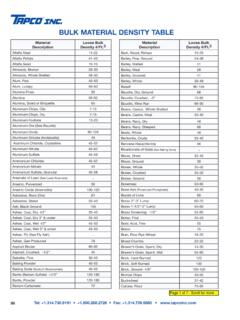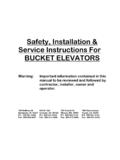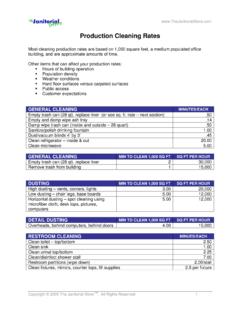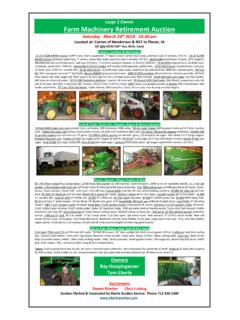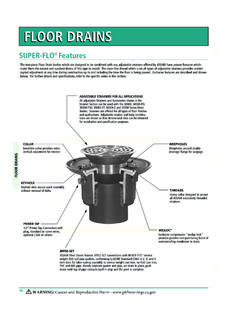Transcription of COMPUTING BUCKET ELEVATOR CAPACITY - …
1 97 Tel: +1. + Fax: +1. BUCKET ELEVATOR CAPACITYNote: Traditional formulas for COMPUTING ELEVATOR CAPACITY are based on the BUCKET manufacturer s published gross BUCKET CAPACITY . Tapco recommends using water level BUCKET capacities because published gross capacities are inaccurate and irrelevant. Tapco can provide the water level CAPACITY for any size and brand of figure the CAPACITY of a BUCKET ELEVATOR you must first know the following: 1. CAPACITY of the BUCKET at water level (cubic inches). 4. SPEED of the belt or chain (feet per minute). See formula below. 2. SPACING of the buckets on the belt or chain (centers). 5. PRODUCT WEIGHT per cubic foot (only if answer is desired in tons or metric tons). 3. NUMBER OF ROWS of buckets on the belt or chain. Then proceed as follows: Multiply the CAPACITY of the BUCKET times the spacing multiplier in the table below times the number of rows of buckets.
2 This will give the ca-pacity in cubic inches of each running foot of the belt or chain. Multiply this times the speed of the belt or chain for the CAPACITY discharged per minute. Then multiply by 60 to get the CAPACITY discharged per hour. The answer will be in cubic as follows: BUSHELS - Divide by 2,150 to convert bushels. CUBIC FEET - Divide by 1,728 to convert to cubic feet. TONS - Multiply cubic feet CAPACITY times weight of product per cubic foot and divide by 2,000. METRIC TONS - Multiply cubic feet CAPACITY times weight of product per cubic foot and divide by 2, now have the water level CAPACITY of the ELEVATOR . Actual CAPACITY would range from 10% to 20% above water level. For engineering purposes, Tapco recommends using 10% above water level CAPACITY . Greater CAPACITY may be realized in the ELEVATOR , however, this is dependent on several factors besides the buckets: head and boot design, loading and discharge, angle of repose of the product, FORMULAS (Based on water level BUCKET fill)For BUSHELS per hour: CAPACITY +10% of BUCKET spacing number speed water actual water level multiplier of rows feet/min.
3 Cu. level CAPACITY actual _____ x _____ x _____ x _____ x _____ _____ = _____ x _____ = _____ _____ x _____ x _____ x _____ x _____ _____ = _____ x _____ = _____ _____ x _____ x _____ x _____ x _____ _____ = _____ x _____ = _____ _____ x _____ x _____ x _____ x _____ _____ = _____ x _____ = _____For CUBIC FEET per hour: CAPACITY cu. +10% of BUCKET spacing number speed water actual cu. water level multiplier of rows feet/min. cu. ft. level CAPACITY actual _____ x _____ x _____ x _____ x _____ _____ = _____ x _____ = _____ _____ x _____ x _____ x _____ x _____ _____ = _____ x _____ = _____ _____ x _____ x _____ x _____ x _____ _____ = _____ x _____ = _____ _____ x _____ x _____ x _____ x _____ _____ = _____ x _____ = _____For TONS per hour: First determine cubic feet/hr. at water level using above formula then proceed as follows: product +10% cu.
4 Weight tons/hr. actual tons/hr. water level per cu. ft.(lbs.) water level CAPACITY actual _____ x _____ _____ = _____ x _____ = _____ _____ x _____ _____ = _____ x _____ = _____ _____ x _____ _____ = _____ x _____ = _____For METRIC TONS per hour: First determine cubic feet/hr. at water level using above formula then proceed as follows: product lbs. metric +10% metric cu. weight metric tons/hr. actual tons/hr. water level per cu. ft.(lbs.) tons water level CAPACITY actual _____ x _____ _____ = _____ x _____ = _____ _____ x _____ _____ = _____ x _____ = _____ _____ x _____ _____ = _____ x _____ = _____606060602,1502,1502,1502, ,7281,7281,7281, ,0002,0002, , , , 31 2" 4" 41 2" 5" 51 2" 6" 61 2" 7" 71 2" 8" 81 2" 9" 91 2" 10" 101 2" 11" 111 2" 12" 13" 14" 15" 16" 17" 18" .92 .86 .80 .75 .71 .67 FEET PER MINUTE FORMULA: Belt or chain speed can be determined if the head pulley or sprocket diameter and of the head shaft is known.
5 Head pulley RPM feet/min. _____ x _____ x _____ _____ = _____SPEED RANGE FOR TAPCO BUCKETS - Contact Tapco Inc. for engineering recommendations on either new or existing multipliers: For determining number of buckets per foot of belt or chain. Below multipliers are calculated by dividing one foot (12") by the BUCKET spacing dimension in Spacing onbelt or chai

